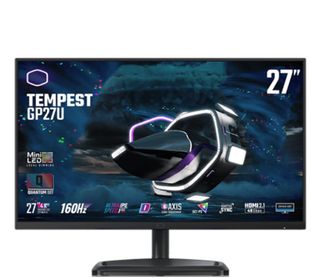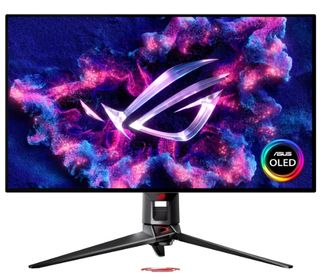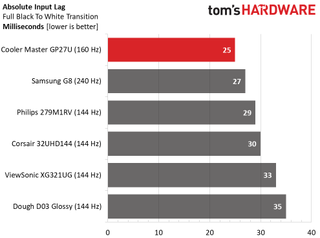Best 4K Gaming Monitors for PC 2024: 144Hz, Curved and More
These are the best 4K gaming monitors to consider if you're ready to upgrade your gaming experience.

The list in brief
1. Best Overall
2. Best Mini LED
3. Best OLED
4. Best Premium
5. Best Budget
6. Best for Consoles
7. Shopping Tips
As mainstream graphics cards become even more powerful, it's not surprising that PC gamers are taking more of an interest in monitors with a 4K resolution. A panel packing 8.3 million pixels (3840 x 2160) makes your favorite games look sharp and realistic. However, that 4K resolution requires a graphics card capable of delivering high enough frame rates to make games playable.
In addition to being one of the most popular resolutions available in a good gaming monitor today, I find that 4K also offers the ability to expand to larger displays while retaining a sharp image. With a packed pixel army, you can stretch your screen size well past 30 inches without having pixels so large that you can see them.
However, that image quality can often come at a steep price. Anyone looking for a 4K monitor knows they're not cheap. Yes, 4K is about high-res gaming (and other media), but you'll still need solid gaming specs, like a 120 Hz-plus refresh rate, low response time, and your choice of Adaptive-Sync (Nvidia G-Sync or AMD FreeSync, depending on your system's graphics card). And you can't forget the cost of the powerful graphics card you'll need to game properly in 4K. See our Best Gaming Monitors page for lower-resolution recommendations if you're not ready to fully embrace 4K.
Our top overall pick is the Alienware AW2725QF, which is an attractively-priced 27-inch monitor that operates at 360Hz at 1080p or 180Hz at 4K. However, it's not the only standout 4K monitor available today; let's look at the other contenders.
The Quick List

Best OLED 4K Gaming Monitor
The Alienware AW2725QF is a "best of both worlds" monitor that can run at a resolution of 1920 x 1080 at 360Hz or 3840 x 2160 at 180Hz. It not only has the build quality we expect from the Alienware brand, but it also has the performance to back it up, along with a competitive price tag of $599.

Best Mini LED 4K Gaming Monitor
Mini LED technology is increasingly emerging in the gaming monitor segment, and the Cooler Master Tempest GP27U is among the best available. The monitor features 576 dimming zones to improve contrast and contribute to a sharp and colorful image. And while 144Hz is the segment average for refresh rates at 144Hz, the Tempest GP27U bumps that to 160Hz (although you do lose Adaptive-Sync if you cross the 144Hz barrier).

Best OLED Gaming Monitor
The Gigabyte Aorus FO32U2P is a monitor that aces nearly every test you throw at it, thanks to its high-quality, accurate, and colorful OLED panel. It not only performs great at 200+ Hz while gaming, but it also has excellent build quality and an expansive array of ports.

Best Premium 4K Gaming Monitor
The Asus ROG Swift OLED PG32UCDP is another dual-mode gaming monitor on our list, although this one is decidedly more premium. This OLED panel can operate at 240Hz at 4K or 480Hz at 1080p, making it one of the best-performing 4K options for gamers.

Best Budget 4K Gaming Monitor
The Asus TUF Gaming VG289Q represents an excellent value for gamers, with a 4K resolution at 60Hz backed by AMD FreeSync compatibility. You won't find 144Hz refresh rates here, but you do get accurate color and a low price of just $289 (even less when on sale).

Best 4K Gaming Monitor for Consoles
The Alienware AW3225QF has a 240Hz refresh rate, 4K resolution, Dolby Vision support, and a 32-inch QD-OLED panel. The monitor bathes you in inky blacks and brilliant colors, which is par for the course for OLED panels, and features a large color gamut.
Best 4K Gaming Monitors You Can Buy Today
Why you can trust Tom's Hardware
Best 4K Gaming Monitor

1. Alienware AW2725QF
Our expert review:
Specifications
Reasons to buy
Reasons to avoid
The Alienware AW2725QF is a perfect example of giving you the best of both worlds. Not only do you get a 1080p display that can boast refresh rates of up to 360Hz, but flipping a switch in the OSD allows you to bump the resolution to the highly-vaunted 4K while stepping down the maximum refresh rate to 180 Hz.
Switch between 1080p and 4K is seamless, and it allows you to dial up the resolution for slower-paced games that don't need a super-fast refresh rate or go to a lower resolution to maximize performance in eSports games. And the AW2725QF does this all at an attractive $599 price point.
Given that this is an Alienware-branded product, it comes loaded with features, including a pop-out hook for your gaming headset, USB-A and USB-C ports for your peripherals, and even support for Dolby Vision. You'll also find the usual gamer-centric features in the OSD like aiming points and night vision as part of the AlienVision viewing enhancement suite.

The monitor performed incredibly well in our response time and total input lag tests, coming in close behind the 480 Hz Asus PG32UCDP at 1080p, yet ahead of the 144Hz competitors in the field. "When input lag is considered, it beats all but a few 500 Hz screens on the market," we said of the AW2725QF in our review. "Since the principal selling point is dual-mode operation, its only real competition is the PG32UCDP, which costs more than twice as much. For $600, the AW2725QF is one of the fastest and most versatile gaming monitors available."
Read: Alienware AW2725QF Dual-Mode Gaming Monitor Review
Best Mini LED 4K Gaming Monitor

2. Cooler Master Tempest GP27U 160 Hz Mini LED
Our expert review:
Specifications
Reasons to buy
Reasons to avoid
Cooler Master is ramping up its gaming monitor portfolio, and the latest from the company is the impressive Tempest GP27U. The is on the smaller side for a 4K gaming monitor at 27 inches, but it brings a lot of features to the table along with excellent performance.
The headlining feature of the monitor is its Mini LED panel with a Quantum Dot film and 576 dimming zones. The result is an expansive color gamut and excellent image quality across the board. Of course, you’ll need to calibrate the Tempest GP27U to get the best performance, but once everything is dialed in, it impresses with deep blacks and overall color performance compared to its peers. On top of that, Cooler Master has thrown in support for up to 160 Hz refresh rates, although you can’t use Adaptive-Sync above 144 Hz.

The GP27U excelled in our input lag test, edging out the Samsung Odyssey G8 by 2ms. Although the G8 returned the favor by beating out the GP27U in overall response time (by 2ms), the latter performed well given its 160Hz refresh rate.
"Though the Samsung monitor’s 240 Hz refresh rate gives it a faster draw time, the Cooler Master has extremely low input lag, making up the difference," we wrote in our review. "My gaming skills are insufficient to see a difference while playing, and the Samsung looks smoother when running over 200fps. But professional-level gamers may gain an advantage from the GP27U’s lower lag."
The Cooler Master Tempest GP27U has loads of accolades on its plate and very few demerits of consequence. Throw in a relatively affordable price of $849, and you have a winning combination for gamers.
Read: Cooler Master Tempest GP27U 160 Hz Mini LED Review
Best OLED 4K Gaming Monitor

3. Gigabyte Aorus FO32U2P
Our expert review:
Specifications
Reasons to buy
Reasons to avoid
The Gigabyte Aorus FO32U2P is one of those rare monitors that does just about everything right with minimal downsides. Sure, it’s hard to find a bad monitor these days, but the FO32U2P does so much right that it stands head and shoulders above similar 4K monitors available on the market.
Part of what makes the FO32U2P so stellar is its use of a high-quality OLED panel, which is becoming standard issue in high-end gaming monitors. The panel refreshes at 240 Hz and supports AMD FreeSync and Nvidia FreeSync technologies. It also supports a healthy number of ports, including two HDMI 2.1, one DisplayPort 2.1, Mini DisplayPort 2.1 (which you don't often see), and DisplayPort 1.4.
When you see so many different monitors come across the test bench over the years, it's easy for them to all start looking similar design-wise. However, the Gigabyte attempts to inject some flair into the FO32U2P's design. "Physically, the FO32U2P stands out thanks to elegant styling. It follows the format of a thin panel with a component bulge in the back," we wrote in our review. "The panel part is just four millimeters thick with a metal backing. The bulge is relatively slim and is set off with LED lighting and a sculpted geometric shape."

Although the monitor needs calibration out of the box, once your settings are dialed in, you'll be blown away by the excellent overall image quality and increased contrast. Throw in class-leading video processing and configurable HDR settings, and you have a real winner on your hands (which, taken together, is why we gave it our Editor's Choice award).
If we must ding the FO32U2P for anything, we could quibble that gamma is a tad light in SDR mode. In addition, the $1,299 price isn’t for the faint of heart.
Read: Gigabyte Aorus FO32U2P Review
Best Premium 4K Gaming Monitor

4. Asus ROG Swift OLED PG32UCDP
Our expert review:
Specifications
Reasons to buy
Reasons to avoid
The Asus ROG Swift OLED PG32UCDP is another dual-mode monitor on our list. However, whereas Alienware AW2725QF is smaller and more attractively priced, the PG32UCDP steps up to the larger and more popular 32-inch segment. More importantly, the PG32UCDP opts for an OLED panel, which pays dividends in overall responsiveness and color reproduction.
The PG32UCDP features a 1080p mode allowing the panel to refresh up to 480Hz. However, you can quickly switch to 4K mode, allowing refresh rates up to 240Hz. Of course, you also get AMD FreeSync and Nvidia G-Sync compatibility, and we witnessed consistently high frame rates without any motion blur.
As we wrote, the PG32UCDP has a premium aesthetic, which uses a combination of metal and plastic. It's a highly ergonomic design that also comes with the usual assortment of HDMI and DisplayPort connections. You even get USB hookups along with a KVM to support multiple PCs. And, of course, we can't forget the ROG logo which projects onto your desk for some added visual flair.

We found the response and total input lag to be class-competitive with other 240Hz monitors, while its 480Hz performance was unmatched. "History is made here with the PG32UCDP’s 480 Hz scores," we said in our review. "The draw time for a full white field is 2ms, and the total lag is 11ms. These are the fastest results I’ve ever recorded for any monitor over the past 12 years. Granted, the resolution is FHD, but the smoothness here is incredible."
The PG32UCDP knocks it out of the park on so many levels, but be prepared to pay for that luxury. It currently has a street price of around $1,200.
Read: Asus ROG Swift OLED PG32UCDP Monitor Review
Best Budget 4K Gaming Monitor

5. Asus TUF Gaming VG289Q
Our expert review:
Specifications
Reasons to buy
Reasons to avoid
The Asus TUF Gaming VG289Q offers tremendous value for gamers looking to step up to 4K resolution without going bonkers on price. The VG289Q has a competent overdrive function, which helps reduce motion blur, and we didn't notice ghosting on the panel.
AMD FreeSync is supported here, although consider that the maximum refresh rate is just 60Hz (FreeSync will work down to 48Hz on this monitor). We can happily say that SDR content looked rich and colorful on the VG289Q, but shifting to HDR didn't really show any improvement. That's to be expected with a a gaming monitor this reasonably priced, where HDR is more of a checkbox feature than one that provides an actual benefit.

This monitor gets the basics right and even has solid build quality. While you do get built-in speakers and a 3.5mm audio jack, you won't find an onboard USB hub. There are also no superfluous add-ons like RGB lighting, which drive up costs. As a result, you can pick up the VG289Q for as little as $240 on Amazon.
But if you're just looking to dip your toes in the 4K gaming monitor market and don't have high-FPS requirements, it's hard to find any serious faults with the VG289Q.
Read: Asus TUF Gaming VG289Q review
Best 4K Gaming Monitor for Consoles

6. Alienware AW3225QF
Our expert review:
Specifications
Reasons to buy
Reasons to avoid
For hardcore console gamers who want to have the best display performance available, there are plenty of options available. However, one that really stands out from the crowd is the Alienware AW3225QF, which is a 32-inch monitor with a 4K resolution, 240 Hz refresh rate, and a brilliant QD-OLED panel. If you own an Xbox Series S/X or PlayStation 5 console, it doesn’t get much better than this.
The monitor supports Dolby Vision on the Xbox Series X and ranks near the top of its class in most categories. Throw in excellent motion resolution and low input lag, and the Alienware AW3225QF is a boon not only to console gamers but also to those of us who prefer PC gaming.

Although you can't make full use of the 240 Hz refresh on today's Xbox and PlayStation consoles, PC gamers are in luck. "The AW3225QF has Display Stream Compression for its DisplayPort 1.4 input and in my tests, I could sustain 240fps in 4K at Doom Eternal’s max detail setting," wrote our Christian Eberle. "The difference in motion resolution between this and 120fps is visibly significant. The higher frame rate also affords lower input lag. The AW3225QF manages that feat as well."
$1,200 is not a small sum by any means for a gaming mointor, but the Alienware AW3225QF is well worth the price of entry.
Read: Alienware AW3225QF Review
Quick Shopping Tips
When seeking the best 4K gaming monitor for you, consider the following:
- 4K gaming requires a high-end graphics card. If you're not using a GeForce RTX 4090 or Radeon RX 7900 XTX, you'll want at least a GeForce RTX 3080 or Radeon RX 6900 XT to game at high-quality settings. Visit our Graphics Card Buying Guide for help.
- G-Sync or FreeSync? A monitor's G-Sync feature will only work with PCs using an Nvidia graphics card, and FreeSync will only run with PCs carrying an AMD card. You can technically run G-Sync on a monitor that's only FreeSync-certified, but performance may vary. We've seen negligible differences in mainstream gaming capabilities for fighting screen tearing between the two. Our Nvidia G-Sync vs. AMD FreeSync article offers an in-depth performance comparison.
- 4K and HDR go hand-in-hand. 4K displays often support HDR content for extra bright and colorful images. But for Adaptive-Sync optimized for HDR media, you'll want a G-Sync Ultimate or FreeSync Premium Pro (formerly FreeSync 2 HDR) monitor. For a noticeable upgrade from an SDR monitor, opt for at least 600 nits brightness. You can learn more from our glossary page on HDR and our buying guide for picking the best HDR monitor.
For more guidance picking a monitor of any resolution--gaming or otherwise--check out our PC Monitor Buying Guide and list of the Best Computer Monitors.
MORE: Best Gaming Monitors
MORE: How We Test Monitors
MORE: All Monitor Content
Stay On the Cutting Edge: Get the Tom's Hardware Newsletter
Get Tom's Hardware's best news and in-depth reviews, straight to your inbox.
Christian Eberle is a Contributing Editor for Tom's Hardware US. He's a veteran reviewer of A/V equipment, specializing in monitors. Christian began his obsession with tech when he built his first PC in 1991, a 286 running DOS 3.0 at a blazing 12MHz. In 2006, he undertook training from the Imaging Science Foundation in video calibration and testing and thus started a passion for precise imaging that persists to this day. He is also a professional musician with a degree from the New England Conservatory as a classical bassoonist which he used to good effect as a performer with the West Point Army Band from 1987 to 2013. He enjoys watching movies and listening to high-end audio in his custom-built home theater and can be seen riding trails near his home on a race-ready ICE VTX recumbent trike. Christian enjoys the endless summer in Florida where he lives with his wife and Chihuahua and plays with orchestras around the state.
-
Muggi1909 hey nice job there, but can you pls take a look on this monitor too, I think personal its the best buy for the bucks if you want a 4k 144hz gaming monitor for around 800 dollars or less :)Reply
Acer Nitro XV273 -
spoidz Did Prices just explode all of a sudden?Reply
Some of the best are back up to $2000 MSRP and not far below at retail. I thought we were seeing lower $1000's a week or so back.
Or maybe I just haven't been noticing, but I have been web "window shopping" these last weeks or so. -
ryzengamer The ASUS VP28UQG freesync 1ms gaming monitor is good and affordable. It comes with a 3 years on site warranty here.Reply -
BulkZerker Replyspoidz said:Did Prices just explode all of a sudden?
Some of the best are back up to $2000 MSRP and not far below at retail. I thought we were seeing lower $1000's a week or so back.
Or maybe I just haven't been noticing, but I have been web "window shopping" these last weeks or so.
This list looks like the same one they released last time. If they haven't reviewed any standout 4kmonitors why change it? -
fry178 anything past 500$ is kind of useless, unless you also using it to "work" on it.Reply
i can buy a 49" 4K tv with 120hz and local dimming for sub 1000 (even brands like sony),
and use a lower res like 1080 to play (tvs upscale 1080p content properly),
which would also reduce (4K related) input lag a bit and will not require a 1070. -
ivoleiden What about the Samsung CRG90 ? 49", super ultra wide 5120 x 1440 , HDR 1000, 120hz (overclockable to 144), native freesync. I ordered one, it's coming tomorrow to replace my 32" QHD 60Hz NoHDR really looking forward!!! only 1,200 Eur!!!Reply -
bendvis Why is the Razer Raptor 27 listed as the best 4k gaming monitor when it's a 1440p screen?Reply -
JonnyDoom Anything less than 32 inch is to small for 4K. Things will be small and far away. 2k works though at around 28 inch.Reply -
mac_angel Replyspoidz said:Did Prices just explode all of a sudden?
Some of the best are back up to $2000 MSRP and not far below at retail. I thought we were seeing lower $1000's a week or so back.
Or maybe I just haven't been noticing, but I have been web "window shopping" these last weeks or so.
Typically stores will jack up the prices before Black Friday and then they can list a sale price and post a bigger difference - "Now $800 off the previous price" -
mac_angel I'm curious with TomsHardware is going to start reviewing FreeSync TVs for gaming. You're bringing up the future of 4k OLED monitors coming, and Alienware's 55" being around $4000. Samsung's 8000 series and up (55" and up) have 4k, HDR and FreeSync. And LG's new firmware for most of their OLED TVs also enable FreeSync. All are much cheaper than Alienware's, even at bigger sizes.Reply